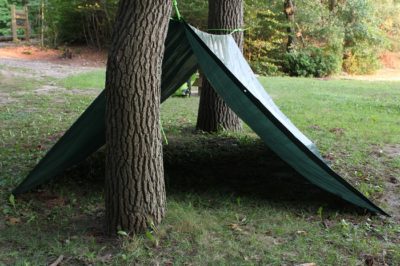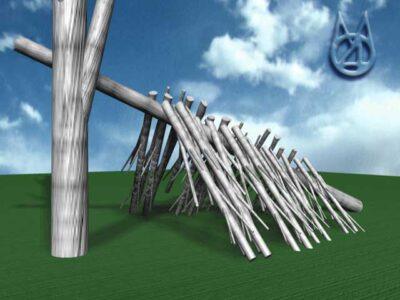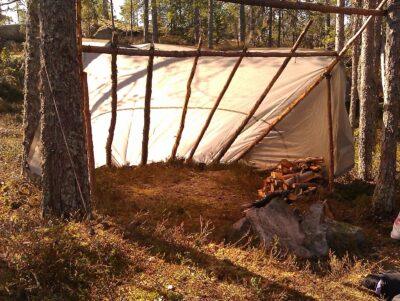
You can use a tarp to build simple yet highly effective survival shelters with limited effort.
When lost, stranded, or injured in the outdoors, adequate survival shelter is of the utmost concern. We may often take for granted shade from the sun or an escape from wind, rain, and cold in our daily life. If disaster strikes, we cannot overlook this essential concern. Thankfully, survival shelters can be as simple or as complex as one wants to make them.
Here, we have an overview of four different types of simple survival shelters that one can set up rather quickly.
Types Of Survival Shelters
1. Tarp Shelters
When preparing to venture into the outdoors, it is highly recommended that some type of tarp and a few feet of rope or cord be included in your gear. The reason for this is that tarp can be used to build simple yet highly effective survival shelters with limited effort. Whether you are stranded in a heavily wooded area or one that has relatively few trees or shrubs, the versatile tarp could very well aid in your survival. A tarp can be spread over a rope tied tightly between two trees in order to form either a lean-to or an A-frame. Guy lines anchored at each corner will pull the survival shelter tight. The closer to the ground, the more it will provide protection from wind and rain.
In addition, there are some outdoors enthusiasts who pack along a sturdy poncho that can double as a tarp for a survival shelter. It is my opinion that it is important to carry both items.
Tarp or poncho survival shelters will be very effective in protecting you from the elements, but neither of them will accomplish this goal completely. The tarp is for shelter and the poncho is for the body. That means a person who’s wearing a poncho and being protected by a tarp shelter is much more likely to remain warmer and drier.
Hand held solar generator provides emergency backup power.
2. Debris Hut

The thicker the layer of debris, the more water and wind resistant it will be and the more it will retain your body heat.
To build a debris hut, it is essential to locate a site that is safe from flooding and falling limbs. Furthermore, you should locate the shelter in an area that has plenty of leaves. Identify the area and clear the ground of all debris. Leave a flat area of dirt around a foot long as your height and about twice as wide as your shoulders.
Construction
Find two branches that are about three feet long and lash them on one end at a 45-degree angle. In addition to that, find a branch that is two feet longer than your height. Next, place one end in the X formed by the lashed branches. Then, place the other end on the ground in the direction of the prevailing wind. Construct the walls by leaning branches against the ridge pole until you fill in the entire length on both sides. Collect piles of leaves and other small debris to pile on top of the structure. The thicker the layer of debris, the more water and wind resistant it will be and the more it will retain your body heat.
For added protection, lash together a U-shaped structure and place it at the opening of the survival shelter. Continue to pile debris on this form, which will decrease the size of the opening and further improve the protection of the design.
3. Lean-To
Step 1

Building a small fire halfway between the lean-to and the wall will reflect the heat and light back into the survival shelter.
You can construct a lean-to with the aid of a tarp if the material is absent. Moreover, it’s possible for you to build the same structure with branches, sticks, and twigs. First of all, place a log horizontally between two trees and about three feet high to construct a sound lean-to. The branches or lashes can support the lean-to securely. You should place the wall on the windward side because it gives adequate protection from wind and rain. The length of the wall and the supporting branches should be approximately 8 to 10 feet long. Also, lean six or seven of these branches against the support beam.
Step 2
Next, you can construct the wall using branches long enough to span the distance between any two of the wall supports. This “roofing” material shall stack or lash to the support from the ground to the top. Once the wall support is covered, further insulation is made by piling grass or leaves. To add warmth and comfort to a lean-to, build up a stone or wood wall three feet from the open side of the structure. Building a small fire halfway between the lean-to and the wall will reflect the heat and light back into the survival shelter.
4. Wedge Hut
The wedge hut brings together the strength and insulation of the debris hut with additional sun and wind protection. A reasonably sized tree with a y-shape split about waist high is necessary for the construction of this shelter. To begin, find a log between two and four inches wide with a height of three feet long. Place one end of the log in the y-split of the tree on the windward side and the other end firmly on the ground. It may seem counter-intuitive to place this facing the wind. However, before the construction is over, you will notice the open entrance of your survival shelter on the leeward side.
Collect many branches that will reach from the center pole to the ground and place them at an angle. Continue placing these branches from the support tree to the end of the support. Choose one side of the large opening as the entrance to the survival shelter. On the opposite side, close it in with branches. Finally, cover the wall with leaves, grass, and twigs as thick as necessary to provide adequate protection from the elements.
You may also be interested in reading our OTGN article: Fire For Survival Part One: Materials And Ignition
What is your favorite type of survival shelter? Tell us in the comments section below.
 Off The Grid News Better Ideas For Off The Grid Living
Off The Grid News Better Ideas For Off The Grid Living



